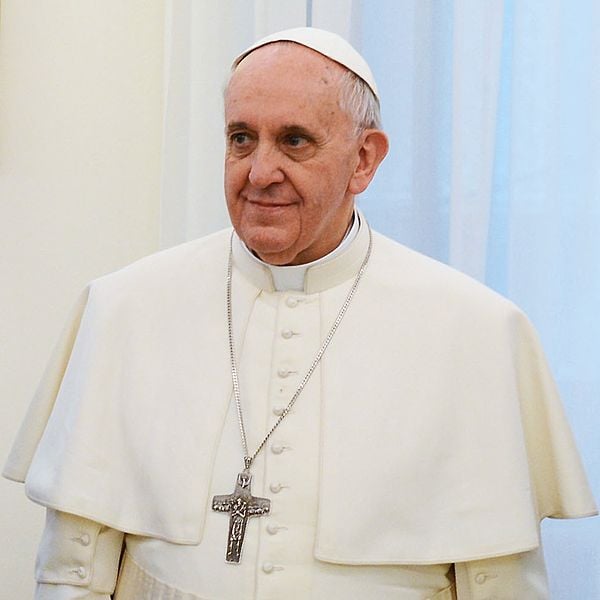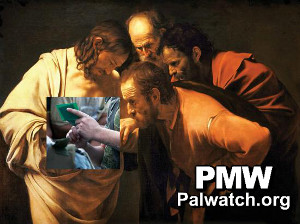
During Pope Francis’ visit to the Holy Land, the Palestinians utilized Christian symbols in order to demonize Israel. No official Palestinian source took advantage of the opportunity to make a peace gesture towards Israel.
Pope Francis recently visited the Holy Land in an effort to promote peace between Israelis and Palestinians. He made a special prayer beside Israel’s security barrier, while also visiting a museum memorializing Israeli victims of terrorism and Yad Vashem, Israel’s national Holocaust museum. He met the Chief Rabbis of Israel, as well as Palestinian religious leaders. Pope Francis invited both Israeli President Shimon Peres and Palestinian Authority Chairman Abu Mazen to pray with him for peace at the Vatican.
However, what was reported less in media outlets across the world is that while Pope Francis was doing his utmost best to promote peace and understanding between Israelis and Palestinians, anti-Israel Palestinian incitement dominated the visit of pope to the region. For example, in honor of Pope Francis’ visit, the Palestinian Authority issued a special art exhibit demonstrating that Jesus was Palestinian rather than Jewish. According to Al Hayat Al Jadida, “The exhibit consists of visual displays merging classical paintings of biblical scenes with photos of Palestinians.”
the visit of pope to the region. For example, in honor of Pope Francis’ visit, the Palestinian Authority issued a special art exhibit demonstrating that Jesus was Palestinian rather than Jewish. According to Al Hayat Al Jadida, “The exhibit consists of visual displays merging classical paintings of biblical scenes with photos of Palestinians.”
Palestinian Media Watch stated in response, “The PA has misrepresented Jesus for years, claiming he was not a Judean as in Christian tradition, but rather a ‘Palestinian,’ thereby claiming a Palestinian history dating back to the time of Jesus. Mahmoud Abbas recently said Jesus was ‘a Palestinian messenger.’ This exhibit reinforces the pretense that Jesus was a Palestinian by visually merging the image of Jesus in classical art with pictures of Palestinians.”
“Some of the displays at the exhibit also reiterate another PA message — that Palestinians suffer as Jesus did,” Palestinian Media Watch noted. “One example of such modified artwork is Raphael’s The Deposition, (1507), which shows the dead Jesus being carried to his tomb. In the Palestinian version, Jesus’ legs have been replaced by a photo of the wounded legs of a Palestinian, being carried away by a man as an Israeli soldier looks on.”
“In the original The Incredulity of Saint Thomas (1602), by Caravaggio, the doubting Thomas inspects the wounds of Jesus to verify his resurrection,” Palestinian Media Watch observed. “In this modified version of the artwork, the wounded part of Jesus’ body has been replaced with a photo of a Palestinian’s identity card, clearly identifying Jesus as a Palestinian. Thomas, presumably representing an Israeli soldier, inspects the card.”
 It should be noted that the famous archaeologist Eric Cline wrote in his book Jerusalem Besieged that there is no direct connection between modern Palestinians and the ancient peoples that inhabited the Holy Land. He stresses that most Palestinians are descended from Arab tribes that arrived in the seventh century and afterwards. However, Cline also noted that there is a consensus among historians and archaeologists that modern Jews are directly descended from the ancient Hebrews, the nation that Jesus was part of. To deny the Jewish roots of Jesus serves the political purpose of denying Israel’s right to exist utilizing Christian imagery.
It should be noted that the famous archaeologist Eric Cline wrote in his book Jerusalem Besieged that there is no direct connection between modern Palestinians and the ancient peoples that inhabited the Holy Land. He stresses that most Palestinians are descended from Arab tribes that arrived in the seventh century and afterwards. However, Cline also noted that there is a consensus among historians and archaeologists that modern Jews are directly descended from the ancient Hebrews, the nation that Jesus was part of. To deny the Jewish roots of Jesus serves the political purpose of denying Israel’s right to exist utilizing Christian imagery.
However, the Palestinian exploitation of Christian symbols was not limited to that art display. In a video the Palestinian Presidential Committee for Church Affairs made leading up to the pope’s visit titled “The Living Stones—Messages from Palestine,” the Palestinian narrator declares, “Jesus came to Taybeh before the Holy Week for respite from his troubles in Jerusalem and the conspiracies plotted against him. He came to Taybeh seeking refuge. That is why we consider Jesus Christ to be the first Palestinian refugee.” In the video, a Palestinian called upon the pope to speak out against Israel.
Latin Patriarch Fouad Twal, in a speech given to the pope himself, reinforced Palestinian incitement against Israel, “So many children today have been reduced by the great of this world to a life of misery. They are often abandoned, homeless, without parents, and are forced to run around the dusty streets of refugee camps, as they have neither roof nor home to protect them. Many are young people and children, friends of the child Jesus, who hear the same words spoken to Mary and Joseph ‘there is no room in the inn.’ There is no place for them, neither in the family policy that decides their fate.”
“There is no place for children in legislations,” the Latin Patriarch declared. “Neither do they take part in negotiations for a peace that never finds its way to reach us, a peace that fails to break through the walls of fear and distrust that surround this city. In the footsteps of the Divine Child, our young people have experienced migration, hunger, cold, and also often, the demolition of their homes. They hunger for a piece of bread, yearn for justice and peace, destitute for a welcoming home. We are not yet done with the present-day Herod’s, who fear peace more than war, who dread the prosperity of families and who are prepared to continue killing.”
“Most Holy Father, your arrival here was preceded by your reputation as a man of God, as a true leader who knows how to govern and a true brother for all of us,” the Latin Patriarch concluded. “We, the descendants of the first shepherds, in response to the invitation of the angels, we are with you in Bethlehem to adore the Child and to pay tribute to His parents.” While the Latin Patriarch demonized Israel as the “present day Herod’s” and praised Palestinians as the “descendants of the first shepherds,” not a single official Palestinian voice took advantage of the pope’s visit to extend a hand of peace towards Israel. An historic opportunity was lost.